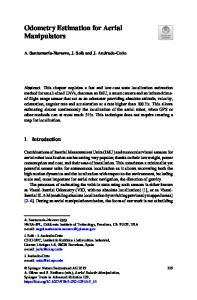Coordinated Control of Multiple Aerial Manipulators
This chapter is focused on the control of systems composed by multiple Aerial Robotic Manipulators (i.e., aerial vehicles equipped with grippers and/or robotic arms). In detail, a hierarchical framework for the control of coordinated motion is presented,
- PDF / 552,272 Bytes
- 13 Pages / 439.37 x 666.142 pts Page_size
- 72 Downloads / 386 Views
Abstract This chapter is focused on the control of systems composed by multiple Aerial Robotic Manipulators (i.e., aerial vehicles equipped with grippers and/or robotic arms). In detail, a hierarchical framework for the control of coordinated motion is presented, based on a three-layer architecture. The developed approach is experimentally tested on a system composed by two multi-rotor aerial platforms, each equipped with a 6-Degrees of Freedom manipulator.
1 Introduction Since a long time, multi-robot systems have been widely investigated, due to their flexibility and capacity to execute complex missions in several application domains. Early work on multiple cooperative manipulators with fixed base were aimed at increasing flexibility and payload capacity of industrial robotic workcells [1], while robotic systems composed by multiple mobile agents have opened the way to a new stream of applications, such as collaborative surveillance, remote monitoring and cooperative rescue missions. Among mobile robotic systems, Unmanned Aerial Vehicles (UAVs) and Aerial Robotic Manipulators (AROMAs, i.e., UAVs equipped with grippers and/or robotic arms) have attracted the interest of researchers for their potential application in several domains. Since aerial manipulators often present severe limitations in terms of payload, teams of AROMAs can be adopted to accomplish missions, such as, e.g., transportation of large and/or heavy payloads [2] and assembly of structures in remote environments [3]. Several frameworks for multi-robot aerial systems have been proposed in literature: in [4] a decisional architecture for multi-UAV systems is proposed, in [5] coordination is achieved via a fuzzy control methodology, while in [6] a multilayer coordinated control scheme is proposed. A relevant problem in multi-robot control is related to task allocation and distribution between the different agents. F. Caccavale (B) School of Engineering, University of Basilicata, Potenza, Italy e-mail: [email protected] © Springer Nature Switzerland AG 2019 A. Ollero and B. Siciliano (eds.), Aerial Robotic Manipulation, Springer Tracts in Advanced Robotics 129, https://doi.org/10.1007/978-3-030-12945-3_14
203
204
F. Caccavale
Distributed task allocation for a multi-UAV sensor network is tackled in [7]. In [8], a control framework for multiple AROMAs is proposed, based on the Null-Space based Behavioral (NSB) control [9]. Recently, a general framework for coordinated control of multiple AROMAs has been proposed and experimentally tested [10]. In this Chapter, a coordinated control framework for a team of AROMAs is presented. In detail, a three-layer approach is adopted: the first layer is a centralized planner, that communicates with each AROMA in the team and generates the trajectories for each end-effector, on the basis of the team motion variables output by the planner; in the second layer, local to each AROMA, motion references are computed, based on the end-effector trajectories output by the upper level; finally, the last layer ho
Data Loading...










